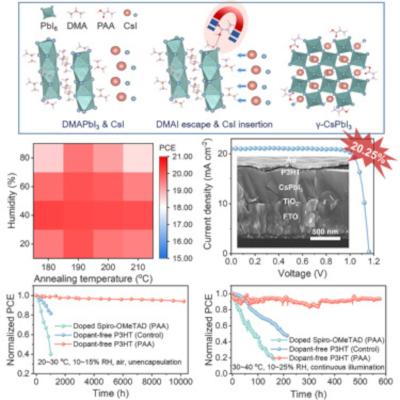Researchers at the Chinese Academy of Sciences (CAS), Beijing Normal University, Beijing Institute of Technology and ShanghaiTech University have developed a universal hydrogen-bonding-facilitated DMA extraction method to fabricate high-quality γ-CsPbI3 films. The researchers fabricated a solar cell based on cesium-lead iodide (CsPbI3) perovskite, which is also known as black perovskite.
The black perovskite solar cell reportedly achieved 20.25% efficiency, which is said by the team to be the highest efficiency reported for PV devices built with this perovskite material and a dopant-free hole transport layer based on the P3HT polymer. The cell was also able to retain around 93% of its original efficiency after continuous illumination for 570 h.
This CsPbI3 material is being tested in PV devices as it may offer superior moisture and illumination stability. This perovskite material has an energy bandgap of approximately 1.7 eV and, according to several scientists, is an ideal solution for single-junction and wide-band-gap sub-cells in tandem PV devices.
The scientists utilized a hydrogen-bonding-facilitated strategy to extract dimethylammonium (DMA) from the black perovskite absorber, which may result in local heterogeneity, defect formation, and rough morphology – all factors that could be detrimental to the cell efficiency and stability.
The strategy consists of bonding DMA with polyacrylic acid (PAA) during the formation of the CsPbI3 film, a process that would favor DMA extraction via the newly formed hydrogen bonds.
The researchers reported that the PAA-added sample exhibited relatively faster phase transformation and achieved the high-quality CsPbI3 film with no DMA residue and that systematic experimental and theoretical investigations revealed that the hydrogen bonding facilitated the DMA extraction by lowering its escaping energy barrier.
The group built the cell with a substrate made of fluorine-doped tin oxide (FTO), a titanium dioxide (TiO2) electron transfer layer (ETL), the CsPbI3 absorber, a hole transport layer (HTL) relying on a regioregular poly (3-hexylthiophene) (P3HT) polymer, and a gold (AU) metal contact.
The device reportedly demonstrated superior moisture and operational stability in terms of maintaining 94% of their initial efficiency after aging at low relative humidity (RH) conditions for 10,224 h and over 93% efficiency after continuous illumination for 570 h.




